Following on from last weeks introduction to stretching, this week we look at key stretches for the hind limbs of the horse and glute and hip flexor stretches for the rider, to keep you both supple and ready for when you can get back on!
There are various stretches you can do for the hindlimbs, however the two below are probably the most useful at this time to keep your horse supple. Both of these stretches are ‘passive stretches’ (sometimes known as assisted stretches), which simply means that the stretch is performed by the handler. This type of stretch is useful to attain a greater range of movement, but do beware, can also carry a risk of injury if you don’t listen to your horse and feel when the stretch is at it’s optimum. These stretches are progressive – they will improve over time. Start slowly and never rush the stretch. Before carrying out any stretches, please see previous blog about the rules of stretching safely. Never, ever perform passive stretches on cold muscles. Ensure your horse is warmed up prior to stretching. Stretching on a surface (arena, rubber matting, grass) is safer than stretching on a concrete yard. If in any doubt about any of the stretches, speak to your Vet or therapist. As with the usual handling of horses, beware that the horse does not kick!
Hind Limb Protraction
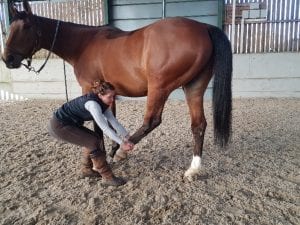
Technique:
Face towards the back of the horse and pick up the foot (as if you were picking the hoof). Supporting the leg at the fetlock and eventually above the hock, gently encourage the hoof forwards and down so it is in line the pastern of the forelimb (same side). Hold the stretch for 5-15 seconds. Replace to the normal standing position gently
Muscles being stretched:
Hamstrings, gastrocnemius, to some extent superficial and medial gluteal muscles
Additional information for performing this stretch correctly:
Support the leg, so the horse feels secure and relaxes the leg into the stretch, rather than forcing it. Let him find is own way. Do not over stretch. This is a difficult stretch for the horse, so may take time for him to relax and perfect the movement. Start small
Hind Limb Retraction
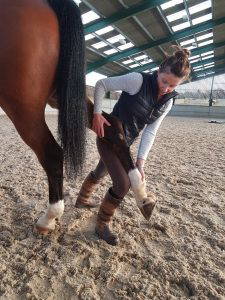
Technique:
Face towards the back of the horse and pick up the foot (as if you were picking the hoof), and hold the leg in a flexed position. Stabilise yourself and place the leg on your thigh and gently lean into a lunge position. Hold the stretch for 5-15 seconds. Replace to the normal standing position gently
Muscles being stretched:
Tensor muscle of the fascia lata, digital extensor muscles, femoral quadriceps. Influences the hock joint, stifle joint and to a degree the extension of the lumbo-sacral junction
Additional information for performing this stretch correctly:
Do not over stretch. This is a difficult stretch for the horse, so may take time for him to relax and perfect the movement. Start small
The same rules of stretching apply to yourselves as well! The stretches below are ‘static’ stretches, or stretches without movement. It is performed by placing the body into a position whereby the muscle / group of muscles to be stretched are under tension. At this point, the position is held or maintained to allow the muscle to lengthen. Exhaling into the stretch once reached, is often a good way to extend the stretch. It is a very safe and effective form of stretching provided you are warmed up beforehand. Again, never ever stretch cold muscles.

Cross over knee stretch
Technique:
Lie on your back. Cross one leg over the other. Bring your foot up to your opposite knee and with your hand pull the knee towards the ground
Muscles being stretched:
Gluteals, piriformis, depending on placement of knee, hamstrings
Additional information for performing this stretch correctly:
Keep your shoulders on the ground. Place your knee higher or lower to get the exact stretch needed (glutes / piriformis / hamstrings)
Leg tuck hip stretch (pigeon pose).
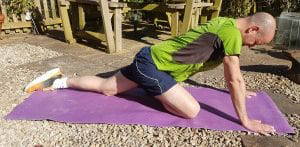
Technique:
Face down. Place one leg (bent) under your stomach and one leg out straight behind. Lean towards the ground
Muscles being stretched:
Gluteals, piriformis, gemellus, quads, hip flexors
Additional information for performing this stretch correctly:
Move into this stretch carefully as it can be a little tricky! Start with placing hands on the ground in front and when confident, can place elbows on the ground. Hold for a minimum of 20 seconds, maximum of 45
Cross leg buttock stretch
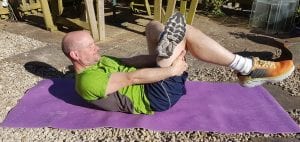
Technique:
Lie on your back and place one foot on the opposite thigh. Slide your hands underneath the thigh and pull towards you
Muscles being stretched:
Gluteals, piriformis, gemellus
Additional information for performing this stretch correctly:
The closer you pull the leg towards you, the greater the intensity of the stretch. Hold for a minimum of 20 seconds, maximum of 45
Rotational hip stretch
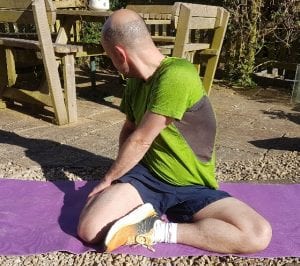
Technique:
Sit with one leg crossed and the other bent behind your buttocks. Lean your whole body towards the leg behind your buttocks
Muscles being stretched:
Pectinius, adductors
Additional information for performing this stretch correctly:
Lean your body as far as you can to increase the intensity of the stretch. Hold for a minimum of 20 seconds, maximum of 45
Search
Recent Articles
- The Good, The Bad and The Ugly of Coaching
- Does your horse need more energy, especially when competing?
- Grade 1 International Para Dressage Rider Di Green- Why Lexi Needed a Year Off
- Louise Blanch – Driving Towards New Horizons with the Continued Support of the Para Equestrian Foundation.
- Kissing Spine – Prevention or Cure?
Categories
- Advice Hub
- Athlete
- Carriage Driving
- Dentistry
- Dressage
- Endurance
- Eventing
- Farrier
- Featured
- Featured Horse Ads
- Featured Posts
- Horse Racing
- Horse's Mouth
- Horseball
- Hunting
- Le Trec
- Leisure Riders
- Mounted Games
- Nutrition
- Polo
- Polocrosse
- Reining
- Rescue & Rehabilitation
- Show Jumping
- Showing
- Tack Room
- Team Chasing
- The Pony Club
- Therapy
- Training
- Vaulting
- Veterinary




